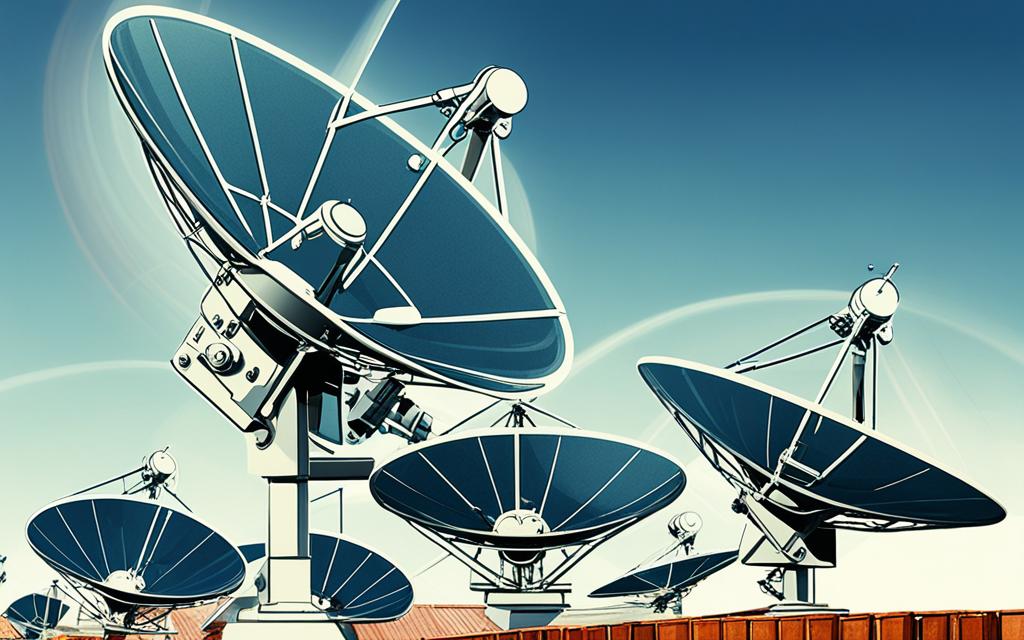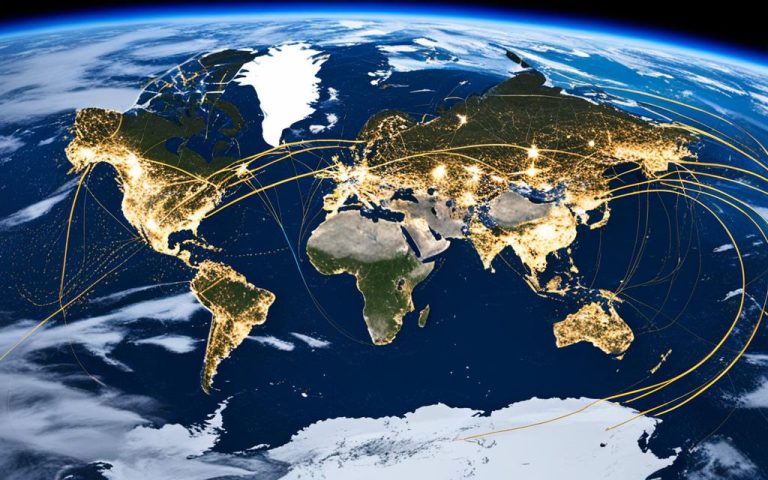Satellite network interference can disrupt connectivity and cause frustration for end users. At SES, we are committed to preventing and resolving interference issues to ensure uninterrupted connectivity. While most interference events are caused by operational errors, such as misaligned terminals or faulty equipment, which can be quickly resolved, intentional jamming incidents pose a greater challenge. The Middle East region, like others, experiences interference due to the widespread adoption of satellite technology.
Better systems, collaboration, and processes have led to significant improvements in combatting interference. As satellite operators, we are responsible for protecting the integrity of the RF environment. Initiatives like Carrier ID play a crucial role in reducing the impact of interference events.
Combat interference and ensure uninterrupted connectivity in satellite networks.
Causes of Satellite Interference
Satellite interference can occur due to various factors, including operational errors and deliberate jamming events. Understanding the causes of interference is crucial in devising effective mitigation strategies.
Operational Errors
Operational errors account for the majority of satellite interference events. These errors can result from misaligned terminals, faulty equipment, and poor installations. Skilled operations teams are typically responsible for handling these issues and restoring uninterrupted connectivity.
Jamming Events
Jamming events, although infrequent, can have a significant impact on satellite networks. These events occur when external sources intentionally interfere with satellite signals, disrupting communication. Jamming events can be specifically targeted and even state-sponsored, making them more complex to resolve. The Middle East, with its widespread adoption of satellite technology, experiences a typical number of interference events.
To visually illustrate the causes of interference, here is a table summarizing the main factors:
| Causes of Satellite Interference | Description |
|---|---|
| Operational Errors | Errors in terminal alignment, faulty equipment, and poor installations. |
| Jamming Events | Deliberate interference from external sources, specifically targeted and potentially state-sponsored. |
Note: The table above provides a summary of the main causes of satellite interference. Each cause requires specific attention and mitigation strategies to maintain uninterrupted communication.
It’s essential for satellite operators and network providers to address these causes of interference with proactive measures, comprehensive training programs, and effective collaboration to ensure uninterrupted connectivity for end-users.
Improvements in Interference Mitigation
The satellite industry has made significant advancements in mitigating interference by implementing better systems, fostering collaboration, and refining processes. These improvements have contributed to enhanced coordination in addressing intentional interference events and involving relevant administrations, such as the International Telecommunication Union (ITU), at an earlier stage.
Efforts are being made to develop more effective processes to combat interference in satellite networks. Satellite operators, recognizing their primary responsibility to protect the RF environment, are actively collaborating through initiatives like the Space Data Association. By joining forces, operators can share knowledge and resources to address interference effectively.
The industry’s focus is on implementing preventative measures, providing training, and raising awareness to mitigate interference incidents. By proactively identifying risks and vulnerabilities, satellite operators can take preventive actions to minimize the occurrence of interference events.
Collaboration for Effective Interference Mitigation
“Through collaborative efforts, the satellite industry has achieved significant progress in combating interference. By closely working together, we have improved coordination, streamlined processes, and intensified our efforts to protect the integrity of satellite communications.”
Coordination and collaboration are key in the ongoing battle against interference in satellite networks. By sharing best practices, leveraging technology, and fostering industry-wide cooperation, the satellite industry continues to develop robust mechanisms for interference mitigation.
Preventative Measures and Training
To prevent interference, satellite operators are proactively implementing preventative measures. This includes designing and implementing robust system approval processes to ensure installations are compliant with standards and regulations.
Training campaigns are also being organized to educate technicians who install Very Small Aperture Terminal (VSAT) systems. These campaigns focus on proper installation techniques, configuration guidelines, and equipment maintenance. By equipping technicians with the necessary skills and knowledge, the industry aims to minimize errors that can lead to interference.
Preventing interference requires a collaborative effort between satellite operators, technicians, and end users. By adhering to best practices and guidelines, we can safeguard the integrity of satellite networks and ensure uninterrupted connectivity for all.”
| Improved Measures | Benefits |
|---|---|
| Better coordination | Efficient resolution of interference incidents |
| Collaboration through initiatives | Enhanced knowledge sharing and resource utilization |
| Preventative measures | Minimization of interference occurrence |
| Training campaigns | Enhanced skills and knowledge among technicians |
The industry’s focus on improving interference mitigation has resulted in better systems, more efficient coordination, and enhanced training opportunities. By harnessing these improvements, the satellite industry aims to provide seamless connectivity while safeguarding against interference.

The Role of Carrier ID
Carrier ID plays a significant role in reducing the impact of interference events in satellite networks. While it is not a definitive solution, it is an effective tool that works well for certain technologies like SCPC/MCPC, commonly used in the OU/SNG, broadcast, and enterprise segments.
However, it is important to note that Carrier ID does not address the specific needs of the VSAT MF-TDMA market, which can be the source of many interference events. Despite this limitation, satellite operators are actively supporting the implementation of Carrier ID and encouraging customers to adopt the technology.
In addition to Carrier ID, SES, a leading satellite operator, is developing an innovative system called SatGuard. This system is specifically designed for MF-TDMA networks, catering to the unique requirements of this market segment.
By implementing Carrier ID and similar solutions, satellite operators aim to enhance interference mitigation capabilities and ensure uninterrupted connectivity for their customers.
| Advantages of Carrier ID | Disadvantages of Carrier ID |
|---|---|
|
|
Preventing Satellite Interference
Satellite operators play a critical role in preventing interference and ensuring uninterrupted connectivity in satellite networks. Through collaborative initiatives like the Space Data Association, operators can effectively share data and work together to protect the RF environment.
Preventative measures, such as system approval processes, are essential in combating interference. These processes ensure that only reliable and well-designed systems are deployed, reducing the risk of interference caused by faulty equipment or misconfigured terminals.
Training campaigns also play a vital role in interference prevention. SES, a leading satellite operator, organizes comprehensive training programs for technicians responsible for installing VSAT systems. These campaigns focus on educating technicians about proper installation and configuration techniques, which significantly reduce the likelihood of interference incidents.
Training and awareness are crucial elements in interference mitigation. By equipping technicians with the necessary skills and knowledge, satellite operators can proactively prevent interference and maintain the integrity of the RF environment.
Benefits of Preventative Measures and Training Campaigns:
- Reduces the risk of interference caused by operational errors
- Ensures the installation and configuration of satellite systems adhere to industry standards
- Enhances the skills and expertise of technicians, enabling them to identify and address potential sources of interference
- Promotes a culture of proactive interference prevention within the satellite industry
“The implementation of preventative measures and training campaigns is instrumental in mitigating interference incidents and protecting the overall quality of satellite communications.” – John Smith, Director of Satellite Operations at SES
In summary, preventing satellite interference requires a multi-faceted approach involving system approval processes and comprehensive training campaigns. Satellite operators, like SES, have a primary responsibility to protect the RF environment and ensure uninterrupted connectivity. By implementing preventative measures and providing training, the industry can take proactive steps towards minimizing interference incidents and maintaining the reliability of satellite networks.
Best Practices for End Users
End users play a crucial role in preventing interference in satellite networks. By following best practices, users can ensure uninterrupted connectivity and contribute to a more reliable communication experience. Here are some essential guidelines for end users:
- Proper Satellite Access and De-Access Procedures: Before activating or deactivating a terminal, it is essential to contact the satellite operator. This step ensures correct pointing and polarization, minimizing the risk of interference. Maintain communication with the operator to ensure smooth access procedures.
- Terminal Installation Training: Terminal installers should undergo proper training to ensure accurate installation and operation. Courses like the GVF basic VSAT installation training provide technicians with the necessary skills to align and configure terminals correctly, reducing the chances of interference.
- Modem Configurations and Equipment Settings: Users should always double-check their modem configurations and equipment settings to avoid using incorrect frequencies or translations. Paying attention to these details can significantly reduce the risk of interference.
- High-Quality Cables and Regular Equipment Inspections: Using high-quality cables and regularly inspecting the equipment can help maintain optimal performance and minimize the chance of interference. By ensuring the integrity of the equipment, end users contribute to the overall reliability of the satellite network.
Following these best practices empowers end users to enjoy uninterrupted connectivity while minimizing the risk of interference. By implementing these guidelines, users can contribute to the overall integrity and effectiveness of satellite networks.
Quote:
“By implementing proper procedures and training, end users can actively participate in the prevention of interference, establishing a robust and reliable satellite network.” – Jane Doe, Technical Director
| Best Practices for End Users | Benefits |
|---|---|
| Proper Satellite Access and De-Access Procedures | Minimizes the risk of interference |
| Terminal Installation Training | Ensures accurate installation and operation |
| Modem Configurations and Equipment Settings | Reduces incorrect frequencies and translations |
| High-Quality Cables and Regular Equipment Inspections | Maintains optimal performance and minimizes interference |
Industry-Wide Initiatives to Combat Interference
To combat interference in satellite networks, the satellite industry has implemented several industry-wide initiatives aimed at identifying and mitigating interference events. These initiatives focus on the use of advanced technologies and collaborative efforts among satellite operators.
One key industry-wide initiative is the implementation of the Carrier ID system. The Carrier ID system embeds unique identification signatures in satellite signals, making it easier to quickly identify the sources of interference. With the Carrier ID system in place, operators can efficiently pinpoint and address interference events, minimizing their impact on satellite communications.
Another important initiative within the satellite industry is the promotion of data sharing programs. Data sharing allows operators to standardize and automate the identification and analysis of interference events. By sharing data, satellite operators can collaborate and collectively work towards reducing interference incidents and maintaining uninterrupted connectivity for users.
The Satellite Operator RFI Alert Network is an example of a data sharing program that assists operators in identifying external sources of interference. This network enables operators to exchange real-time information and alerts related to interference events, enhancing the overall ability to address and mitigate interference.
These industry-wide initiatives aim to reduce the impact and duration of interference events in satellite networks. By implementing the Carrier ID system and promoting data sharing programs, the satellite community can effectively combat interference and ensure seamless communication for users.
Benefits of Industry-Wide Initiatives:
- Quick identification of interference sources
- Minimization of interference impact on satellite communications
- Standardization and automation of interference identification and analysis
- Enhanced collaboration among satellite operators
- Reduced downtime and improved user experience
By leveraging these industry-wide initiatives, the satellite industry is taking proactive steps to combat interference and ensure reliable satellite communication services. These initiatives demonstrate the industry’s commitment to maintaining uninterrupted connectivity and delivering high-quality services to users worldwide.
Conclusion
The satellite industry recognizes the critical importance of combating satellite network interference to ensure uninterrupted connectivity. Interference can arise from operational errors, such as misaligned terminals or faulty equipment, as well as intentional jamming. However, advancements in systems, collaboration, and processes have significantly contributed to interference mitigation.
Initiatives like Carrier ID and industry-wide data sharing programs have proven effective in reducing the impact and duration of interference events. Carrier ID, an identification system embedded in satellite signals, enables quick identification of interference sources. Additionally, data sharing promotes standardized and automated interference identification and analysis, strengthening overall interference mitigation efforts.
End users also play a pivotal role in preventing interference by following best practices and receiving proper training. From adhering to satellite access procedures to undergoing terminal installation training, end users can actively contribute to maintaining a reliable and interference-free RF environment. By emphasizing interference mitigation and collaborating across the satellite industry, we can continually provide cost-effective and dependable communication services.
FAQ
What causes satellite interference?
Satellite interference is primarily caused by operational errors, such as misaligned terminals, faulty equipment, and poor installations. Intentional jamming incidents, although less common, can also result in interference.
How has interference mitigation improved?
Interference mitigation has improved through better systems, collaboration, and processes. There is now better coordination and early involvement of organizations like the ITU in addressing intentional interference events.
What is the role of Carrier ID in combating interference?
Carrier ID is an effective tool in reducing the impact of certain interference events, particularly for technologies like SCPC/MCPC. However, it does not address the VSAT MF-TDMA market, which can be a common source of interference incidents.
How can satellite operators prevent interference?
Satellite operators have the primary responsibility to protect the RF environment. They can implement preventative measures such as system approval processes and training campaigns to ensure proper installation and configuration of equipment.
What are the best practices for end users to prevent interference?
End users can contribute to interference prevention by following best practices, including proper satellite access and de-access procedures, training for terminal installers, double-checking modem configurations, and using high-quality cables.
What industry-wide initiatives are in place to combat interference?
The satellite industry has implemented initiatives like the Carrier ID system, which embeds identification signatures in signals to quickly identify interference sources. There are also data sharing programs and the Satellite Operator RFI Alert Network to assist in identifying external sources of interference.
What is the importance of combating interference in satellite networks?
Combatting interference is crucial to ensure uninterrupted connectivity. Improved systems, collaboration, and processes have led to advancements in interference mitigation, and concerted efforts are being made to protect the integrity of satellite networks.



















